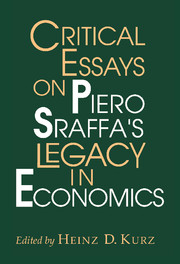Book contents
- Frontmatter
- Contents
- Preface
- List of contributors
- Part I Introduction
- Part II Returns to scale, demand, money and interest, and the classical tradition
- Part III Long-period theory and the problem of capital
- Part IV Intertemporal equilibrium theory and the problem of capital
- 10 Paradoxes of capital and counterintuitive changes of distribution in an intertemporal equilibrium model
- 11 Savings, investment and capital in a system of general intertemporal equilibrium
- Mathematical Note by Michele Tucci
- Author index
- Subject index
11 - Savings, investment and capital in a system of general intertemporal equilibrium
Published online by Cambridge University Press: 05 June 2012
- Frontmatter
- Contents
- Preface
- List of contributors
- Part I Introduction
- Part II Returns to scale, demand, money and interest, and the classical tradition
- Part III Long-period theory and the problem of capital
- Part IV Intertemporal equilibrium theory and the problem of capital
- 10 Paradoxes of capital and counterintuitive changes of distribution in an intertemporal equilibrium model
- 11 Savings, investment and capital in a system of general intertemporal equilibrium
- Mathematical Note by Michele Tucci
- Author index
- Subject index
Summary
Introduction
1. The criticism of neoclassical theory based on the inconsistency of the concept of a ‘quantity of capital’ has been met from the orthodox side essentially with the claim that the contemporary reformulations of the theory do not rely on any such concept. The present chapter is intended as part of a larger work concerned with showing that the deficiencies of that concept do in fact undermine those reformulations no less than they do for the traditional versions. The limited aim of the present chapter is that of providing a basis for the wider argument by bringing to light the form which the concept of capital takes in an intertemporal general equilibrium system.
In Section 2 we shall introduce for the purpose the very simple model which Professor Hahn put forward in 1982 to counter what he took to be the ‘neo-Ricardian’ critique. That model will allow us to bring out the decisions to save and to invest of any ‘year’ which are implied in the intertemporal equations. In Section 3 we shall then define what can be described as the ‘general-equilibrium saving–supply schedule’ and the ‘general-equilibrium investment-demand schedule’ for such a ‘year’. In Section 4 we shall consider the determination of those schedules and then, in Section 5, the information they can provide on the behaviour of the system. Section 6 deals with alternative techniques and the effect of them on investment demand.
Finally, in Section 7, we shall consider the presence and significance of the concept of a ‘quantity of capital’ in intertemporal general equilibrium.
- Type
- Chapter
- Information
- Critical Essays on Piero Sraffa's Legacy in Economics , pp. 392 - 445Publisher: Cambridge University PressPrint publication year: 2000
- 17
- Cited by

